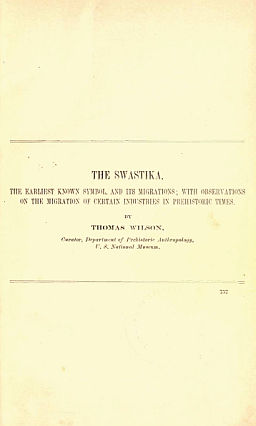
Full PDF online at Internet Archive
| Text to be formatted | Images to be added | [CD-Rom Home] |
 Full PDF online at Internet Archive |
Report of National Museum, 1894.
Preface.
An English gentleman, versed in prehistoric archaeology, visited me in the summer of 1814, and during our conversation asked if we had the Swastika in America, I answered, "Yes,'' and showed him two or three specimens of it, he demanded if we had any literature on the subject. I cited hIm De Monfortillet, De Morgan, sad Zmigrodzki, and he said, "No, I mean English or American?' I began a search which proved almost futile, as even the word Swastika did not appear in such works as Worcester's or Webster's dictionaries, the Encyclopedic Dictionary, the Encyclopedia Britannica, Johnson's Universal Cyclepedia, the People's Cyclopledia, nor Smith's Dictionary of Greek and Roman Antiquities, his Greek and Roman Biography and Mythology, or his Classical Dictionary.
I also searched, with the same results, Follett's Dictionary of Art and Archeology, Fairholt's Dictionary of Terms in Art, "L'Art Gothique," by Gouza, Perrot and Chipiez's extensive histories of Art in Egypt, in Chaldea and Assyria, and in Phoenicia; also "The Cross, Ancient and Modern," by W, W, Blake, "The history of the Cross," by John Ashton and a reprint of a Dutch work by Wildener, In the American Encyclopedia the description is erroneous, while all the Century Dictionary says is "Same as fylfot,"and "Compare Crux Ansata and Gammadion". I thereupon concluded that this would be a good subject for presentation to the Smithsonian Institution for "diffusion of knowledge among men."
The principal object, of this paper has been to gather and put in a compact form ssuc informaation as is obtainable concerning the Swastika, leaving to others the task of adjustment of these facts and their arrangement into an harmonious theory. The only conclusion sought to be deduced from the facts stated is as to the possible migration in prehistoric times of the Swastika and similar objects.
No conclusion is attempted as to the time or place of origin, or the primitive meaning of the Swastika, because these are considered to be lost in antiquity. The straight line, the circle, the cross, the triangle, are simple forms, easily made, and might have lean invented and reinvented in every age of primitive man and in every quarter of the globe, each time being an independent invention, meaning much or little, meaning different things among different peoples or at different times among the same people; or they may have had no settled or definite meaning. But the Swastika was probably the first to be made with a definite intention and a continuous or consecutive meaning, the knowledge of which passed from person to person, from tribe to tribe, from people to people, and from nation to nation, until, with possibly changed meanings, it has finally circled the globe.
There are many disputable questions broached in thus paper. The author is aware of the difference of opinion tbereon among learned men, and he has not attempted to dispose of these questions in the few sentences employed in their announcement, he has been conservative and has sought to avoid dogmatic decisions of controverted questions. The antiquity of man, the locality of his origin, the time of his dispersion and the course of his migration, the origin of bronze and the course of its migration, all of which may be more or less involved in a discussion of the Swastika, are questions not to be settled by the dogmatic assertions of any individual.
Much of the information in this paper is original, and relates to prehistoric more than to modern times, and extends to nearly all the conotries of the globe. It is evhdent that the author must depend on other discoverers; therefore, all books, travels, writers, amp students have been laid under contribution without scruple. Due acknowledgment is hereby made for all quotations of text or figures wherever they occur.
Quotations have been freely made, instead of sifting the evidence and giving the substance. The justification is that there has never been any sufficient marshaling of the evidence on the subject and that the former deductions have been inconclusive; therefore, quotations of authors are given in their own words, to the end that the philosophers who propose to deal with the origin, meaning, and cause of migration of the Swastika will have all the evidence before them.
Assumptious may appear as to antiquity, origin, and migration of the Swastika, but it is explained that many times these only reflect the opinion of the writers who are quoted, or are put forth as working hypotheses.
The, indulgence of the reader is asked, and it is hoped that he will endeavor to harmonize conflicting statements upon these disputed questions rather than antagonize them.